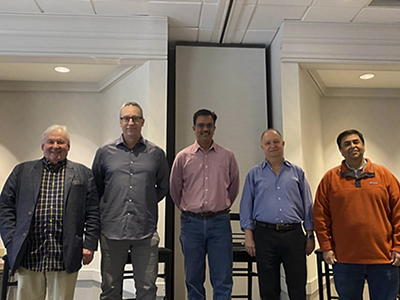Cloud native EDA tools & pre-optimized hardware platforms
To adapt to new customer demands such as convenience, safety, autonomy, and electrification, the automotive industry is moving to software-defined vehicles (SDVs) based on more powerful electrical/electronic (E/E) architectures. With the emergence of SDVs, it is expected to see an increase in the vehicle software content since they can streamline and accelerate the ability to deploy software to vehicles. Historically, vehicles shipped with software did not change much, if at all. They also force the industry to move from lengthy development cycles with complex maintenance schedules to a more agile development approach, allowing for continuous over-the-air (OTA) updates over the vehicle lifespans.
On March 28th, NXP announced a breakthrough for SDV development with the open S32 CoreRide platform. This platform combines processing, vehicle networking, and system power management with pre-integrated software to address the complexity, scalability, cost-efficiency, and development efforts required for next-generation vehicles. NXP also introduced the S32N family of vehicle super-integration processors offering best-in-class, real-time performance that enables S32 CoreRide central compute solutions, empowering OEMs with efficient, flexible processing choices.
“Our new S32 CoreRide platform greatly simplifies complex vehicle architecture development and breaks vehicle function integration barriers for software-defined vehicles to help reduce costs for automakers,” said Brian Carlson, global marketing director for automotive processors at NXP. “Together with Synopsys, we are enabling automotive companies to deploy ECU and vehicle-level electronics digital twins efficiently, start development earlier, reduce validation costs and accelerate availability of higher quality software throughout the vehicle lifecycle.”
Enabling Electronics Digital Twins with S32 Processor VDKs
Starting development earlier, reducing verification and validation costs and delivering high-quality software and systems to reduce maintenance and recalls are essential to accelerate automotive development cycles and customer satisfaction. Synopsys enables automotive companies to deploy electronics digital twins and accelerate automotive SDV development. Through our center of excellence collaboration with NXP, we are delivering fast, high-quality and proven Virtualizer Development Kits (VDKs) for NXP S32 processors that are at the core of electronics digital twins representing end nodes, zone controllers and central compute. Synopsys VDKs supports the S32G, S32E, S32K, and the newly announced S32N, families of automotive processors. They are used within NXP to development software development kits (SDKs), ensuring a validated combination of VDK + SDK, and support a broad range of operating systems from multiple vendors. The VDKs provide integration with the electronics digital twin fabric, enabling a full set of ecosystem integration from vehicle dynamics, sensors, and environment simulation to software development, test automation, and engineering tools. Today, Synopsys S32 VDKs are deployed in automotive electronics digital twins at many OEMs and Tier 1s worldwide.

The S32N55 Virtual Prototype
The scalable S32N family, purpose-built for the highest level of automotive functional safety, offers multiple combinations of real-time and applications processing cores to meet a wide range of automakers’ central compute needs. All S32N devices integrate an advanced hardware security engine and multi-port TSN Ethernet switch and CAN hub, with some also supporting Ethernet packet acceleration, AI/ML acceleration, and cost-effective inter-compute PCI Express services.
The S32N55 processor is the first member of the S32N family. It excels at safe, centralized, real-time vehicle control that demands high-performance, deterministic compute supporting the highest level of functional safety. Through software-defined, hardware-enforced isolation, it can host dozens of vehicle functions with different levels of criticality, while providing freedom from interference between them.
The S32N55 virtual prototype from Synopsys provides a comprehensive development platform for the S32N55 enabling software developers to debug and analyze their software efficiently, leading to faster turnaround and higher software quality. It includes the processing subsystem, the security sub-system, functional safety models, PCI Express communication interface, multi-port TSN Ethernet switch and CAN hub. It is integrated with familiar software development tools such as Lauterbach Trace32, gdb, Green Hills Multi, iSystems winIDEA, as well as Synopsys VDK advanced debug and analysis capabilities.
The Synopsys S32N55 virtual prototype has been deployed at a leading OEM and its Tier1’s supply chain for more than a year, enabling the OEM to shift left their software development and accelerate the development of SDV capabilities.

Cloud Deployment
Cloud deployment is essential to achieve the highest-level efficiency and utilization of electronics digital twins. It is essential to achieve cloud-to-edge system parity, deliver efficient collaboration platforms, and scale for peak validation demand. Synopsys and NXP collaborated to establish a virtual development environment using the Amazon Web Services (AWS) global cloud infrastructure. This environment includes NXP S32 Design Studio IDE and Synopsys S32E virtual prototype. Amazon Machine Images (AMIs) are used to create virtual machine instances using Amazon Elastic Compute Cloud (EC2). It provides a complete system parity, allowing developers to efficiently develop their software in a cloud environment before executing it in a physical environment. NXP’s demonstrator have shown the equivalence between virtual and physical results. We invite you to see in action in the NXP S32 Cloud Studio demonstration at the NXP booth (4A-222) at embedded world 2024 in Nuremberg, Germany.
From Software-in-the-Loop to Test Automation
Automotive systems software development and testing require a broad set of technologies to efficiently create and use digital twins. NXP S32 processor VDKs enable the creation of Virtual ECUs at Level 4 a/b. In addition, Synopsys provides Virtual ECUs from L1 through L3 abstraction with Silver. Silver is a broadly- deployed tool. Silver Virtual ECUs, combined through the electronics digital twin fabrics with Virtualizer-based Virtual ECUs, enable the deployment of fast multi-abstraction electronics digital twins.
Accelerating and scaling testing is a key purpose of digital twins. It requires test automation technologies. TPT is a test automation tool for embedded software and systems, with an emphasis on automotive platforms. It supports all testing activities from test case design/generation, test execution, test assessment and reporting, as well as test management and requirements traceability. Whether you create a simple module test or a complex system test, TPT provides unique features to flexibly and intuitively create those tests. Safety standard directives can be satisfied while testing with TPT up to the highest safety level. Relevant standards, such as ISO 26262, are well supported. Developers of NXP S32 processor-based systems can benefit from TPT’s test-efficient capabilities.
Visit Us at Embedded World
Visit Synopsys (Booth 4-451) and NXP (Booth 4A-222) at embedded world 2024 where a joint demonstration will be shown. For more information, please contact Synopsys.












